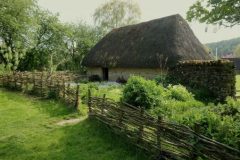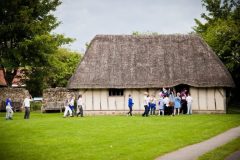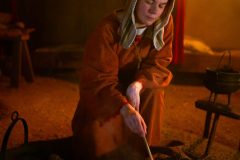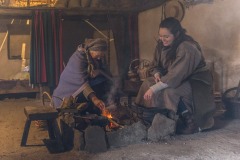Life for the Anglo-Saxons
After the end of the Roman occupation of Britain, around 410AD, there ensued a struggle for control of the British isles. Invading tribes had already posed a threat in these parts under Roman occupation. Signal stations had been built along what is now the Yorkshire coastline, including at Scarborough and Filey, to warn of attack from the sea.
The following centuries were dominated by inhabitants from invading tribes. The Angles (from whom we get the name ‘Angle-land’ or England) and the Saxons were both Germanic tribes. They created kingdoms across the country. The region of the North York Moors, where Ryedale Folk Museum is located today, was originally in the kingdom of Deira, with Elmet to the west and Bernicia to the north. These areas were united to form Northumbria, literally meaning the people to the north of the Humber.
It was a large and important kingdom and continued to be fought over. Part of the kingdom was conquered by the Danes – Vikings from Denmark – and became known as the Danelaw. This is why we have many Anglo-Saxon and Viking place names in this part of Yorkshire.
Saxon names include –
- Brough, borough or burgh for fort
- Feld and field for field
- Dene for valley
- Ham and wick mean farm or farmstead
Meanwhile, Viking words include –
- Beck for stream
- Dale for valley
- Kirk for church
- Thorpe for small village
These resources have been created to help you learn a bit more about daily life in these parts for the Anglo-Saxon people, although it should be remembered that this period of history also overlapped with Viking occupation.
We know a little bit about the life of some Anglo-Saxons here from archaeological evidence, for example a sixth-century brooch from Bulmer, near York, and the grave of a young woman which was found near Hawnby in the North York Moors. She had gold and silver hair pins, a stone spindle whorl and a bronze bowl. Burials like this give us great insights into life for some people, though they were not always typical.
For most ordinary Anglo-Saxons, life would have been hard and survival uncertain. At Ryedale Folk Museum, you can explore our simple, single-room dwelling, with earth floor, an open fire in the centre and living quarters shared with animals.
Daily life
Try our virtual mini workshop.
If you’re planning a trip to Ryedale Folk Museum, your students can take part in our virtual workshop before their visit. Alternatively, the workshop could be used as a standalone resource for anyone unable to visit us.
In the video, you can meet an Anglo-Saxon housewife, trying her best to keep up with the chores. She won’t know what to make of your students! You’ll discover what jobs ordinary peasants, known as ceorls (pronounced churls), would have had to do in Anglo-Saxon times and how children today would have been viewed as adults from the age of 10, although everyone would have been expected to work, even toddlers.
Watch the workshop video in advance so you know what to expect, then encourage your students to call out answers to the questions and take part actively. Afterwards, you could talk about what surprised the children about life in Anglo-Saxon times. What chores would they prefer to do?
Explore our Crofter's Cottage
If you are planning an educational trip to Ryedale Folk Museum, we would encourage you to talk to your students about what they will see here. This footage will prepare students for where they are coming.
If you are unable to visit, we hope this footage will support you to explore this Anglo-Saxon-style dwelling from the comfort of your classroom instead.
Questions to Talk About
As you watch the film footage or explore the space as part of a school visit, you can talk about the similarities to, and differences from, our homes today. You could also discuss some of the following questions with your class.
How many rooms were in an Anglo-Saxon house?
During Anglo-Saxon and Viking times, the homes of poorer people often only had one room in which all daily tasks were completed – unlike today when we have separate spaces for cooking and sleeping. Some wealthier families would have had an additional room for sleeping, sometimes reserved for the parents.
Why do you think the house was dark?
You’ll probably notice that the dwelling doesn’t have any window glass – any windows would be very small to prevent draughts from entering the house and they would be kept covered in bad weather and at night, for example with shutters. In a time long before electricity, this would mean that buildings were very dark.
Any light would be from candles or oil lamps, or from the central fire.
Why is there a fire in the centre of the room?
The fire would have been important, not just for warmth, but also for the cooking. Mealtimes were important and we know from stories of the period that feasting was seen with excitement! People used their fingers to eat as they wouldn’t have had cutlery.
Though lots of foods which we’re used to enjoying wouldn’t have existed, Anglo-Saxons still enjoyed a varied diet, with fruit (blackberries, raspberries, plums and apples), vegetables (onions, carrots, cabbage and peas), milk, cheese and bread. They also farmed animals which gave them meat (cows, pigs, sheep, goats and chickens) and fished.
What was the quern stone for?
The Anglo-Saxons and the Vikings grew wheat, barley and rye and used these to make bread – the quern stone was needed to grind the grain as part of preparation for baking.
The quern in the Anglo-Saxon style home is a beehive-quern (which is the shape of a beehive). This was an improvement on the traditional quern stone. Grains were poured into the central hole and the handle was turned in a circular motion. This rotational movement allowed the grains to be ground more efficiently and evenly, helping to remove the husk and produce a finer flour.
What colours were the materials, such as clothing and curtains, in the Anglo-Saxon house?
Materials were made from natural resources, such as wool, from sheep, or linen, from flax. The colours in the Anglo-Saxon style home seem less bright and varied than our own because they would all need to be made from natural materials, including dyes and brighter colours would have required more time-consuming work to make.
Accessories such as leather belts and metal-work brooches were also greatly valued and would have been worn by those who could afford them.
Why did the animals sleep inside the house?
Bringing livestock inside the home at night would help protect them from wild animals such as foxes or wolves. It would also protect their animals from the elements. Some creatures would be brought in for the whole of winter. But it did mean that houses would have been much dirties and less hygienic than today.
At Ryedale Folk Museum – planning your visit
During an educational visit, you’ll be able to explore our simple Anglo-Saxon style home with your students.
Inside the building, your students can mime some of the chores mentioned in the workshop video – for example, milking the cows, churning the butter, sweeping the floors after the pigs made a mess, bringing water in from the stream, chopping the firewood, making candles, and grinding the grain for bread.
Don’t forget to download and photocopy Spotter Sheets to help your students explore the space.
If you want to tell stories in the Manor House, don’t forget to prepare some in advance. You can use our resources to help you.
You can also create Anglo-Saxon-style riddles at Ryedale Folk Museum using our worksheet to help.
You can also download a PDF of all the notes on this page.
Booking Information
You can book self-led visits to our site by emailing [email protected] or by calling 01751 417367.
The cost of a self-led group visit is £6 per child including VAT, with an accompanying adults visiting for free.
